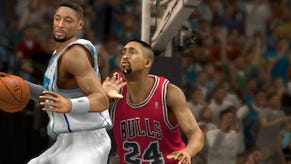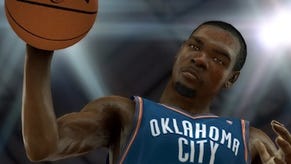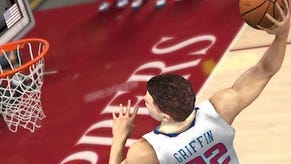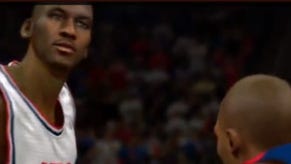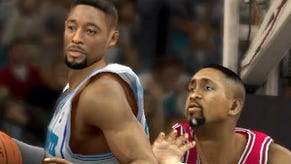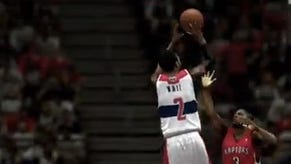NBA 2K13 – slam-dunking the lack of opposition
Visual Concepts has its sights set on becoming the number one sports game studio on the block. Senior producer Rob Jones tells us how it intends to achieve this goal.
It may seem difficult to wrap one’s head around the concept of how the NBA 2K series — a franchise with no direct competitor — can continue to improve on each yearly iteration. As Visual Dynamics’ Rob Jones explains, it’s a matter of not treating the series as a code with any peers but, instead, approaching continued development as a franchise that competes against every other sports title out there.
VG247: Rob, why was it so important to have NBA 2K13 on the Wii U?
Rob Jones: As long as the Wii has been out, we’ve never felt that we’ve been able to give Nintendo the full experience that the Xbox 360 and the PlayStation 3 were getting. Our game is extremely popular around the world as the only basketball game out there for the NBA, and yet we kind of felt like graphically, the Wii just didn’t have the power. We were getting accolades for our presentation, for our audio, for the lighting and the player’s look, and the Wii version looked like an old-school videogame.
It sure did.
Our second part was that the Wii U has some specific features that we wanted to take advantage of. Controllers have gone from one button to two, to six, to eight, to 10; it seems like it’s button crawl. But at the heart of it, basketball should really be played with two buttons: pass and shoot. One of the things we’ve always struggled with, especially as we’ve gotten deeper and we’ve had such a great following, is that the most vocal people are the ones that want the most advanced features.
What about your casual players?
You don’t want to lose your casual players. But what we wanted to do, especially for this demographic specifically, was to really make it simple to get them to learn that there’s more. What we find is we’re creating all these features and nobody’s using them. It’s really frustrating from that standpoint because, if they knew they were there, I think that they’d be a lot more successful at our game.
Are you anticipating offering even deeper Wii U support in future titles?
Think about it, we’re seven years into the Xbox 360 lifecycle, and Kinect has been out going on its third Christmas. After three years, this is the first time we’ve actually supported Kinect, and that’s because we find more ways to squeeze power out of the Xbox 360 as we go forward. We’re obviously going to want to be able to support the microphone in a better way, or the camera. But one of the things we’ve learned through experience in making these games is, if we try to actually make the game relative to the peripheral or the features of the console, we stray so far from that core experience that has made us so successful that we never want to do that again.
So what you’re saying is implementing things like Kinect and the Wii U gamepad have to make sense, right?
If you think about it, when we first did NBA on the Wii, we were really trying to take advantage of that pointer. Nobody bought the game. It didn’t play the same that they had fun with. When we did Move, it was a very similar thing. We wanted to make it simple like a point-and-click game. Nobody wanted to play it. There’s a reason you’re successful: do what makes it successful, and then incorporate what the hardware is giving you, as long as it makes sense. We’ve learned the hard way with PlayStation 3D, too. People were excited about it, but it didn’t sell any more units. It was just like, ‘Yeah, we can do 3D.’ Two years later, we don’t even do 3D.
Integrating those sorts of potentially superfluous features becomes a big deal, too, when you’ve got a yearly release model.
By the time we finish the game, there’s a list of things we didn’t finish that already prepopulates our new list, and then we have all of these great ideas that we’ve learned from playing other games that came out. Those populate, and those start mapping things out. In the gameplay department, we had a whiteboard with all the features we wanted to do, and we reordered them as we started feeling one thing more important than the other. What didn’t make the list, we just crossed off from the top.
As the items were completed?
As they were done. But what didn’t make the list, just didn’t make the list. You didn’t worry about it. If you were working at your fullest and you’re knocking off the things in order of importance, well guess what? What was at the bottom wasn’t important enough to make it in the scheduled time that you had.
That must be frustrating in a sense, though, for something that was up the top and then gets deprioritised.
Once you start work on something, you finish it. That’s the main thing. But if you haven’t started on something and you suddenly realise that something else comes in, like, the Kinect feature came in and it bumped out another feature that we had planned on doing. The Kinect feature took three engineers and one producer to make it work. That means that something else wasn’t going to get done. Very simple. People sit there and be like, ‘Why didn’t you use the microphone on Wii U? You’re already doing Kinect.’ Because the microphone would’ve meant a performance decrease, because it always does, because the voice-recognition software runs in the background and decreases our performance, which then means that somebody would have to sit there and figure out how to make it perform. Then you would’ve lost something else. It’s a very simple give-and-take situation.
How far ahead do you plan content for a series like this?
I tell ya, I worked on Madden football, and I left before we ever shipped the PlayStation 2 version, but Madden ‘01, Madden ‘02 and Madden ‘03 were still implementing features for the design that we wrote in ‘99 when we left. On NBA 2K, for the first time we finally did a true All-Stars league this year on DLC. People have been asking for that for six years and we’ve never done one. Now that we have a good base under us, we can focus on these other things and make them the way we would envision them. You don’t want to put it out half-assed just because someone asked for it.
How do you guys keep pushing NBA further when you don’t have any other basketball games to compete with?
We know that we’re still lacking in areas where basketball plays differently than the videogame does. And as long as that’s there, we feel that we have work to do. Secondly, believe it or not, we are now competing cross-sport. Now that we’re doing so well, we actually want to be the best sports game out there.
How do you achieve that goal?
I try all these other sports games, and I’m actually mentally competing to be the best sports game. We learn from everything that everybody’s doing well, and then we try to best those games. We know what we’re not doing well in basketball, and we know what everyone else is doing better than us in terms of, ‘Hey, their players feel a little bit more responsive than ours,’ or, ‘This control scheme actually seems to work for them. How would it actually apply to our basketball game?’ We do a lot of those types of comparisons and then try to make our game the best game we possibly can.
If you’re getting it closer and closer to actual real-life basketball, are you worried it will become too much of a simulation and not enough of the arcade jump-in-and-play casual-type game?
No, because in basketball itself, those guys who have incredible skill make it look like an arcade game. For instance, LeBron makes it look like it’s an arcade game. You’re sitting there watching players like him and you’re like, ‘Might as well be a videogame.’ That’s the way we feel about it, he’s playing with them like we would do in the videogame. I think that basketball lends itself to being a kind of arcade-feeling game. It’s our job as developers to actually make it feel more sim-like.
Won’t that alienate casual players?
If you watch most users, not one of them calls a play; they all do all the little dribble moves, they all shoot with LeBron, Wade or Coby and expect every single shot to go in. ‘What do you mean it didn’t go in?’ ‘There were four guys draped off his back.’ ‘So? That’s Coby.’ That’s the reaction you get from your most casual users. It’s about teetering that line between those players and our most ardent fans. The guys that come back every year love the simulation side of it.
What do you think are the good and bad things about moving forward into a future where these types of non-standard controllers—Kinect, Move the Wii U gamepad—are becoming more prevalent?
The Wii U’s idea is actually a very practical idea, the way I look at it. Just holding it in my hand, it can feel a little bit cumbersome in terms of the size of the pad, but when you look at the size of the screen that’s in between and what it’s doing for you, I think that it’s a better overall ergonomic experience than, say, a PlayStation Vita. Nintendo was actually smart about building a peripheral that way. I also think the physical controller is there to stay. I don’t think you’re going to be sitting there in your living room jumping to avoid obstacles in Zelda. I’m just sayin’.
Fingers crossed.
I’m hoping not, because I don’t think that’s what the customer is looking for. I think you’ll see games like, say, a Halo or a Call of Duty, they’re only going to incorporation portions of what those systems can do to fit what people are already doing with those games, because it’s all about efficiency. If you feel like you’re efficiently using the tech, you’ll use it. If you’re not, you won’t.
That’s back to the idea of it making sense to implement.
Right. That’s what we did with Kinect. You can say, ‘Run a three-point play for Dwight White,’ and the computer would recognise it, pass it and find the play for him and run it for you. If you see a guy’s tired and you say, ‘Substitute Coby Bryant,’ it would get another guy on. It fit. It did exactly what I didn’t want to do with the controller. I didn’t have to go find any menus, everything was there for me.
In real time, too.
In real time, yeah. As opposed to, some guy was like, ‘I want to be able to put a fist up and it’s going to call a play.’ And I said, ‘You want Kinect to recognise you have a fist up, or two; doesn’t that mean you’re taking your hand off your controller while you’re doing that?’ That doesn’t make any sense to me, and that’s always been my whole thing: if it doesn’t make sense, I don’t want to do it.
You’ve been with Visual Concepts for a little while now.
I’ve been there since ‘01.
What are some of the biggest milestones for the franchise of which you’ve been a part?
Being a basketball player, I didn’t really feel like we were representing basketball the way I experienced it on the court until the ‘06 version. ‘07 was our blowout version: the first version where everybody was like, ‘You guys better recognise 2K.’ Everybody always said we were a great game, and in ‘07, everybody was like, ‘That is the game.’ The past three years I feel like we’ve surpassed the previous year, whether or not everybody felt it, a lot of the things that we did eclipsed the previous version in terms of quality and in terms of execution. It’s been a long time coming to become a consistent developer, from my quality standpoint. Yes, we always sold well; we did good games, and we got better. But to put an A+ game and then to consistently develop an A+ game year in, year out, that takes some work.
NBA 2K13 is a blast to play across platforms, and is available on all major platforms now (the Wii U version ships in January for Australia).



